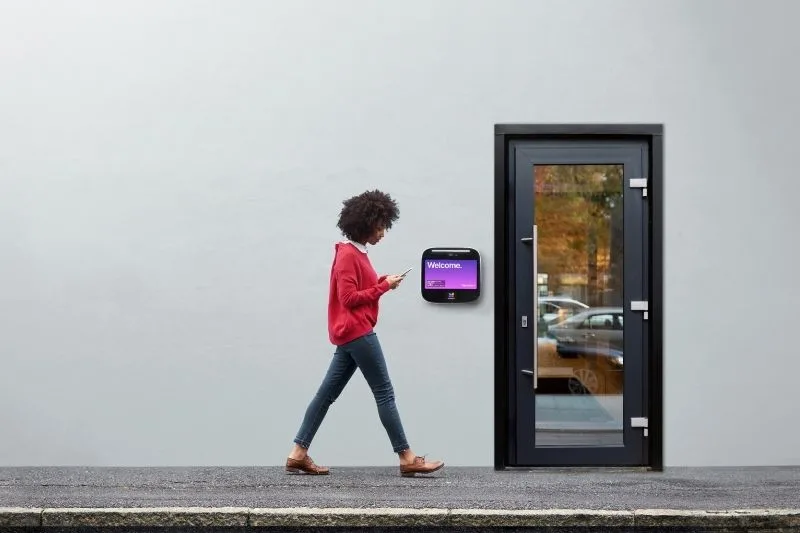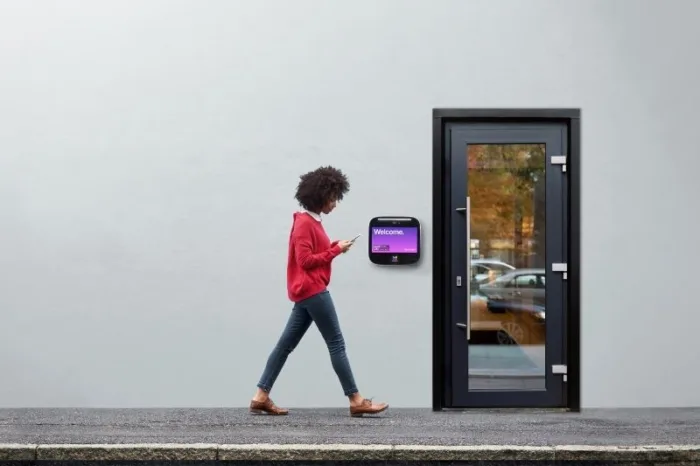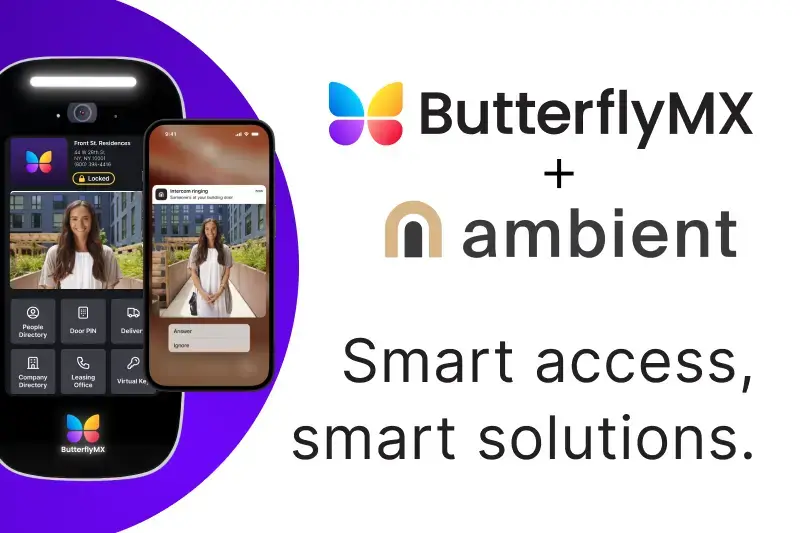Key takeaways
- Unlike first-gen and offline systems, next-gen platforms are built on reliable connectivity and unified architecture, driving measurable improvements in resident satisfaction and operational efficiency.
- Seamless, branded experiences — like curb-to-couch access and reliable remote control of in-unit devices — give properties a competitive edge in attracting and retaining tenants.
- Smart thermostats, keyless access, and automated unit turnover deliver thousands in annual savings per property while easing the burden on on-site staff.
- Even great technology can fail without quality implementation — next-gen providers like Ambient offer in-house project management, installation guarantees, and ongoing support that reduce risk and deliver results.

There are seemingly endless smart apartment technology solutions out there, but little clarity on which ones will actually deliver the operational efficiencies and resident experiences that drive real value. Choosing technology for an acquisition or new development represents a critical strategic crossroads — one where selecting the right platform can dramatically impact NOI and resident satisfaction.
Smart building solutions fall into three distinct categories: next-generation platforms, first-generation systems, and offline technologies. Among these, only next-generation technology truly moves the needle.
In this guide, we examine the critical differences between next-gen, first-gen, and offline technologies for multifamily properties, demonstrating why next-gen tech represents the most strategic investment.
This post covers:
- The evolution of smart apartment technology
- Why tech decisions matter right now
- The case for avoiding offline technologies
- Comparing next-gen to first-gen technologies
- The next-gen difference: technology that delivers real results
The evolution of smart apartment technology
The distinctions between smart technology reflect fundamental architectural differences that determine whether your investment will create lasting value or become a costly disappointment. You should understand the specific capabilities and limitations of each approach before making any investment decisions.
Next-gen: Next-gen smart apartment platforms are built on reliable connectivity infrastructure that unifies smart tech across your property, from building entry and common area access to in-unit devices, property management systems, and apps for residents and staff. These platforms extend your property’s brand while creating seamless experiences for residents and reducing operational burden.
First-gen: First-gen smart apartment platforms are early solutions with inconsistent device connectivity, generic app branding, feature bloat, and lack of accountability during and after deployments, which result in frustrating user experiences all around.
Offline tech: Disjointed, piecemeal devices that aren’t network-connected. These solutions fail to enable experiences like remote access management and property-wide automation. Examples include fob-only access systems and Bluetooth-only locks.
Why tech decisions matter right now
Current market conditions make strategic technology investments more critical than ever. Multifamily is facing a few simultaneous challenges:
- Generationally high supply has shifted market dynamics and intensified competition across many markets.
- Rent concessions remain high as properties compete for occupancy. Rent concessions have increased substantially, with many communities offering 4-8 weeks free.
- Operating costs continue rising. Escalating expenses in maintenance, insurance, and staffing compress margins further.
In this environment, technology offers two powerful levers you can pull to put yourself ahead: an improved resident experience and operational efficiency.
Smart technology demonstrably improves resident satisfaction, helping to boost retention and acquisition efforts. A June 2024 survey by Cox Communities and Multifamily Dive shows that “an impressive 97% of Property Decision Makers said adding new technologies has both improved resident satisfaction and helped attract new residents.”
Simultaneously, smart technology creates measurable operational savings:
- Lower energy costs with smart thermostats that enable remote climate control in vacant units.
- Average annual vacant unit cost savings: $6,816*
- Time saved managing access with keyless access solutions that eliminate physical key management and storage.
- Average annual access management time savings: 250 hours/year*
- Streamlined unit turnover with property-wide access solutions that automate the process of granting and revoking access and eliminate rekeying costs for every unit turn.
- Average annual rekeying cost savings: $5,800*
*In an average 250-unit building.

The case for avoiding offline technologies
As you plan your smart tech investment, you can start by ruling out the least effective category: offline technologies.
Referring to offline technologies as “smart” is a misnomer — truly smart technology requires reliable, remote connectivity. Offline technologies like fob-only access systems and Bluetooth-only locks can’t “communicate” with each other, preventing the meaningful experiences that modern residents expect. A lock or thermostat that can’t be adjusted remotely offers minimal operational advantages over its analog predecessors.
Why offline technology falls short:
- Requires storage, management, and carrying of physical keys or fobs
- Creates fragmented prospect and resident access experiences with multiple apps and credentials (e.g. PIN codes, fobs, keys)
- No remote access management to alleviate operational burden (for monitoring and managing access, easy credentialing)
These limitations represent a meaningful competitive disadvantage in a market where resident experiences increasingly drive leasing decisions.
Discover our complete beginner’s guide to access control:
Comparing next-gen to first-gen technologies
While first-generation smart technology represents an improvement over offline solutions, it falls significantly short of what next-generation platforms deliver.
Let’s break down how next-gen compares to first-gen tech in terms of:
- Resident experience
- Operational burden
- Connectivity for even the most challenging environments
- Accountable field services and installation
Resident experience
The resident experience gap between next-gen and first-gen technologies manifests in residents’ daily interactions with the property. Distinctions between the two directly impact the perceived value of smart amenities and their ability to justify premium rents.
Operational burden
The difference between first-generation and next-generation platforms becomes starkly apparent when you assess their ability to reliably automate critical operational functions. The operational advantages of next-gen platforms directly strengthen your bottom line by lowering expenses and delivering the operational efficiency that shields your assets from market volatility.
Connectivity for even the most challenging environments
Network architecture is a fundamental distinction between first-gen and next-gen platforms. These technical differences determine whether your smart technology actually works for every property in your portfolio.
Accountable field services and installation
Even the best smart apartment platform can fail without proper implementation and ongoing support — a reality many owners and operators only discover after spending thousands on a first-gen solution. Field service quality represents the hidden factor that separates successful deployments from costly disappointments.
The next-gen difference: technology that delivers real results
Choosing between next-gen, first-gen, or offline technology isn’t just a technical decision — it’s the difference between a solution that transforms your property’s performance and one that simply exists on your amenity list.
Next-generation platforms stand apart through their ability to deliver:
- Standout resident experiences that serve as meaningful differentiation in competitive markets.
- Operational improvements that save time, reduce energy costs, prevent property damage, and maximize NOI.
- Reliable connectivity that ensures consistent performance across your entire property, regardless of building style.
- Dependable field services that eliminate hidden costs and ensure the technology performs as promised from day one.
Want to learn more about Ambient’s integration with ButterflyMX? Book your free consultation with Ambient today.

Author’s Bio:
Ambient is the next-generation smart apartment platform, uniquely delivering smart access, automation, and intelligence solutions that improve apartment living and management in the most impactful, cost-effective way possible. Learn more about Ambient or follow Ambient on LinkedIn for the latest industry perspectives, trends and insights.

Get your free quote!
Fill in the form below, and we'll email you right back.
Want a free quote?
Fill in the form below, and we'll email you right back.
You’ll be redirected shortly...






